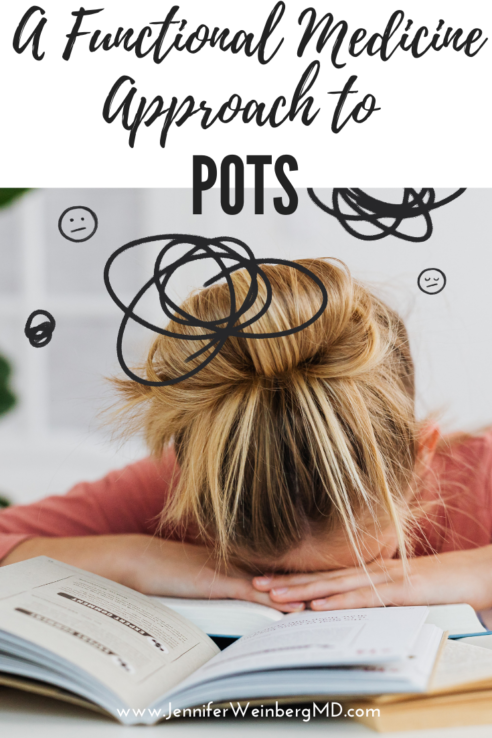POTS: A Functional Medicine Approach
POTS: A Functional Medicine Approach
This Article Was Originally Published on Rupa Health”
Postural orthostatic tachycardia syndrome (POTS) is a form of dysautonomia or dysfunction of the autonomic nervous system that can cause debilitating and unpredictable lightheadedness and rapid heart rate upon standing. Although often missed, POTS impacts an estimated one to three million Americans with a growing number of patients experiencing POTS symptoms after recovering from COVID as well.
Affiliate Disclosure & Privacy Policy (please review our complete policy here): we use affiliate links and analytics on our website. This post is NOT sponsored. These statements have not been evaluated by the FDA and should not be considered medical advice or treatment. Please consult your personal health provider before making any changes to your diet or lifestyle.
The autonomic nervous system is composed of three major divisions: the sympathetic and parasympathetic branches and the enteric nervous system. Together, these control the “automatic” functions of the body that you do not consciously think about, such as heart rate, blood pressure, digestion, dilation and constriction of the pupils of the eye, kidney function, and temperature control. Since the autonomic nervous system is responsible for regulating most of the largely “automatic” functions of the body, dysautonomia can impact the body’s ability to regulate temperature, heart rate, breathing, and sweating.
For more details about the autonomic nervous system, dysautonomia, and POTS, I have a 3-part series here:
- For a general Overview of the Autonomic Nervous System check out part 1 here
- To learn more about the Various Forms of Dysautonomia in part 2 here
- And here for a Dysautonomia Treatment & POTS Survival Kit: Lifestyle Medicine Management of Postural Orthostatic Tachycardia Syndrome and other forms of Dysautonomia
POTS Signs & Symptoms
There are individual variations in presentation, but in general patients suffering from POTS have trouble regulating some or all of the functions of the autonomic nervous system like heart rate and blood flow. This results in symptoms like
- lightheadedness,
- fainting,
- abnormal heart rate,
- palpitations or a feeling of fluttering or racing in the chest,
- fatigue, and
- exercise intolerance.
Fluctuations in heart rate and blood flow that result from the underlying dysfunction of the nervous system contribute to additional neurologic symptoms such as
- difficulty concentrating,
- headaches,
- tremulousness,
- sleeping difficulties, and more.
Since the autonomic nervous system is closely intertwined with the nervous system in what has been coined the gut-brain axis, dysfunctional control of automatic functions can also impact the gastrointestinal tract causing
- nausea,
- constipation,
- diarrhea, and
- malnutrition.
Some POTS patients also experience issues with dysfunctional bladder control that can lead to
- excessive urination or
- repeated nighttime urination.
Skin impacts like
- rashes,
- flushing, or
- pallor may also occur.
These symptoms can vary from day-to-day and make it difficult to carry out normal activities of daily life such as bathing, eating, exercising, working, and housekeeping.
Diagnosis is based on symptoms and a persistent increase in heart rate (tachycardia) of at least 30 beats per minute in adults, or at least 40 beats per minute in adolescents, measured during the first 10 minutes upon standing or sitting upright (hence the term “postural”) without a drop in blood pressure, in the absence of dehydration or blood loss. This can be assessed by recording heart rate and blood pressure while lying down and during a 10-minute standing test (with minimal stimulation) or via further autonomic testing using a Tilt Table Test.
POTS Possible Causes
POTS is a syndrome or collection of symptoms that can have a variety of underlying causes and present in different ways. It may develop following viral or bacterial infections including Lyme disease, Epstein Barr virus, Mycoplasma pneumoniae , and recently SARS-CoV2. It may also arise following other stressors on the body like injuries, surgeries, chemical or mycotoxin exposures, or traumatic events. Dysautonomia can also occur due to deficiencies or imbalances of certain vitamins, including vitamins E, B1 (thiamine), B3 (niacin), B6 (pyridoxine), and B12 which are essential to healthy nerve function.
While studies investigating the root causes of POTS are ongoing, research suggests that at least some patients develop POTS due to an autoimmune response where the body makes antibodies directed against its own cells and tissues such as receptors in the autonomic nervous system. Patients with POTS and their close relatives show a higher than expected prevalence of other autoimmune conditions like celiac disease, Hashimoto’s thyroiditis, systemic lupus erythematosus (SLE), and Sjögren’s syndrome.
Another root cause of POTS may be dysfunction or imbalances in the sympathetic side of the autonomic nervous system. The sympathetic branch of the autonomic nervous system is responsible for preparing the body for the demands and stress of daily life and for responding to emergencies, giving it the nickname the “fight or flight” response. It stimulates vital organs and glands to trigger responses that allow the body to prepare to flee or fight off danger such as an increased heart rate and increased blood flow to skeletal muscles, cardiac muscle and the lungs. Some patients have a hyperadrenergic form of POTS with overactivity of the sympathetic nervous system resulting in elevated levels of the stress hormone norepinephrine/noradrenaline. This can cause additional symptoms like tremor, anxiety, elevated blood pressure, and cold sweaty extremities while upright and can sometimes be associated with mast cell issues like mast cell activation disorders.
In addition to mast cell dysfunction, POTS is often associated with genetic connective tissue disorders such as Ehlers-Danlos syndrome (EDS). The hypermobile form of EDS is characterized by joint hypermobility and other musculoskeletal dysfunction, skin texture abnormalities, and vascular and visceral dysfunctions. Other genetic variants (polymorphisms) in the NOS3 and ADRB2 genes have also been associated with an increased risk of developing POTS.
Functional Medicine Labs to Test for POTS
A functional medicine approach to evaluating a patient with symptoms suggesting imbalances in the autonomic nervous system should rule out other possible conditions that could also explain or mimic these symptoms such as adrenal or thyroid disorders, anemia, dehydration, and nutrient or electrolyte deficiencies.
Find out how to test for factors that can lead to POTS in my article on Rupa Health Magazine here.
Functional Medicine Treatment for POTS
The management of POTS requires a multidisciplinary approach that addresses identified underlying causes and modulates symptoms. The presentation of dysautonomia is heterogeneous and often involves several coexisting conditions which must be considered, so treatment plans must be individualized in conjunction with a knowledgeable health care provider. Conventionally, therapies to increase blood volume like fluid and electrolyte intake, and medications to control heart rate and/or cause peripheral vasoconstriction are used.
Exercise
Physical therapy and individualized exercise programs may be prescribed. Often POTS patients tolerate horizontal exercises like rowing, swimming, or cycling on a recumbent bike better at the beginning to avoid the upright posture that elicits their POTS symptoms. Various versions of a structured exercise program featuring endurance (aerobic) conditioning with some resistance (strength) training for the lower body have been developed to support POTS patients. Exercise protocols should be adapted for those with comorbid joint hypermobility or musculoskeletal pain.
Volume Expansion
Consuming water along with salt or electrolytes is most effective for long-term volume expansion. Fluid intake of approximately two liters per day is often recommended, but this must be individualized. Maintaining adequate hydration raises the level of the stimulatory neurotransmitter norepinephrine, helping to maintain blood pressure.
In patients who have normal cardiac and renal-adrenal function and non-elevated norepinephrine, adequate hydration and electrolyte balance can maintain blood volume to control symptoms. POTS patients with hypovolemic symptoms are recommended to gradually increase daily salt intake up to 10 grams per day, adjusted for individual needs. Himalayan or Celtic salt contain minerals in addition to sodium to support adrenal function along with blood volume and are free from anti-clumping agents, added iodine, and other additives typically found in table salt. Natural electrolyte powders without dyes, additives, or artificial flavors and sweeteners or organic coconut water naturally containing potassium, sodium, chloride, and carbohydrates can support hydration. Salt tablets should be avoided because they are very concentrated and can induce an osmotic load into the stomach that can cause nausea, vomiting, and further dehydration.
A fluid intake of approximately two liters per day is often recommended, but this must be individualized under the guidance of a health care professional. Maintaining adequate hydration is thought to raise the level of the stimulatory neurotransmitter norepinephrine, helping to maintain blood pressure. Consuming water along with salt or electrolytes is most effective for long-term volume expansion. Increased salt intake should of course be avoided in those with kidney disease or heart failure and is not appropriate for those with hyperadrenergic POTS.
Sleeping with the head of the bed elevated off the ground 4 to 6 inches using large phone books, blocks of wood, or bed risers placed under the feet at the top of the bed places the entire body at a slight angle during sleeping at night. This is believed to increase circulating plasma and blood volume over time by creating a mild orthostatic stress that induces fluids to shift to the lower body and decreases central blood volume and the effective circulating blood volume to activate the renin-angiotensin-aldosterone system, leading to salt-water retention and overall volume expansion.
Reduction in venous pooling
Patients with POTS seem to have increased venous pooling in the legs when upright, which may be due to dysfunctional vascular tone. Lower body gradient compression garments extending at least to the upper abdomen or abdominal binders can help to counteract venous pooling.
Nutrition and Food Intolerances
It is frequently recommended that POTS patients eat several smaller meals throughout the day in lieu of two or three large ones, since much of your blood is redirected to the digestive tract after eating a large meal to facilitate the digestive process which can exacerbate symptoms.
Many also experience fewer symptoms when limiting simple carbohydrates and consuming meals with a balance of protein, healthy fats and complex carbohydrates. This may be due to the role of insulin. Insulin is released by the body in response to consuming carbohydrates or other sources of glucose to help maintain a constant range of blood sugar. Insulin also has important vascular impacts, altering blood flow and contributing to vasodilation especially in the gut area.
As with all lifestyle approaches, bioindividuality is important. Food allergies and sensitivities can contribute to symptoms in some people with POTS. Of course, each individual responds differently, so these guidelines must be considered carefully depending on different circumstances.
Stress Reduction
Stress can exacerbate the symptoms of POTS, resulting in further imbalances in the autonomic nervous system. Therefore, the use of personalized daily relaxation techniques such as breathing, meditation, gentle stretching, and mindfulness practices can help many patients.
Addressing Root Causes
Functional medicine further searches for and addresses the root causes of the autonomic dysfunction and attempts to reverse the dysfunction by removing ongoing underlying triggers. For example, identifying and treating things like mold exposure, Lyme disease, chronic smoldering viral infections, and nutrient imbalances can help reduce POTS symptoms.
Some patients with accompanying adrenal dysfunction may benefit from adaptogens or licorice root, which can sometimes be used as an alternative to Florinef, a steroid medication which is sometimes prescribed to treat adrenal dysfunction and POTS but this must be individualized with a knowledgable and qualified healthcare provider.
Given the potential role of autoimmunity in the etiology of POTS, immunomodulatory approaches may play a role in treatment including intravenous immunoglobulin (IVIG).
Summary
A properly functioning autonomic nervous system is crucial for maintaining balanced function in involuntary actions that allow the body to function well. A growing number of people are suffering with dysfunction of this system resulting in a range of symptoms classified as POTS.
With this illness can be complex with a variety of underlying causes, a functional medicine approach that recognizes and addresses the various root causes that may be causing the autoimmune reaction or sympathetic dysfunction underlying the autonomic imbalances can help patients restore daily functioning.
Comprehensive testing for underlying causes that can contribute to the vast array of symptoms, addressing these underlying issues, and enacting appropriate lifestyle adaptations may help POTS patients reduce and cope with symptoms such as fluctuations in blood pressure, heart rate, and digestion.
Join us on Instagram for more functional medicine & mindfulness information!
Medical Disclaimer: Information provided in this post and related resources are for informational purposes only. Jennifer Weinberg is not providing medical advice, diagnosis or treatment information. The information is NOT intended as a substitute for the advice provided by your physician or other healthcare professional. Every body is unique so be sure to check with your healthcare professional before making any dietary or lifestyle changes, taking any medication or nutritional supplement or using any treatment for a health issue. Do not use this information provided for diagnosing or treating a health problem or disease. If you suspect you have a medical problem please contact your healthcare provider promptly and do not disregard professional medical advice based on anything on this website. This website and related resources are not intended to diagnose, treat, cure or prevent disease and do not create a doctor-patient relationship between you and Jennifer Weinberg. These statements have not been evaluated by the FDA. These products are not intended to diagnose, treat, cure, or prevent any disease.







Comments
Anna Hicks
Is it possible to get an appointment with Dr. Weinberg? Or maybe even a referral to a Doctor that specializes in Pots?. My daughter has been suffering for many years with a full list of Pots symptoms and is having trouble finding a Doctor that will work with her.
Shamiza
Am I able to get an appointment with DrWeinberg?
Even if virtual
Many thanks
Shamiza